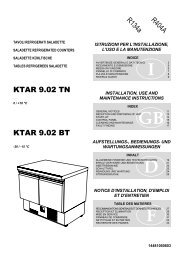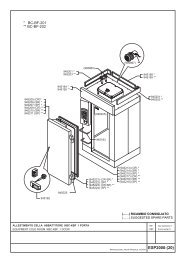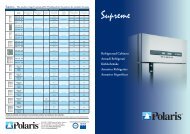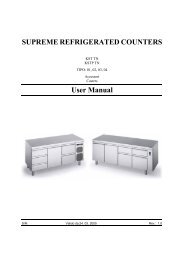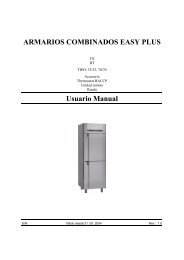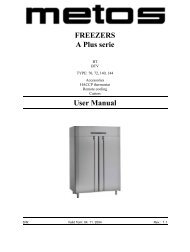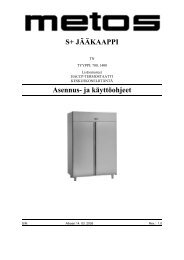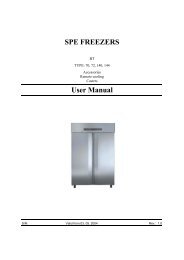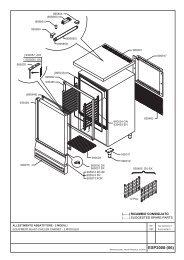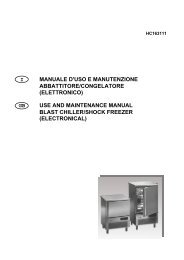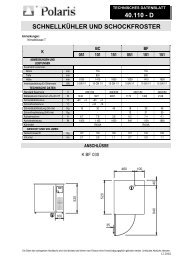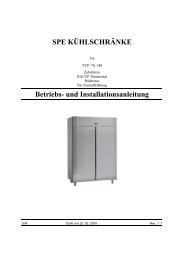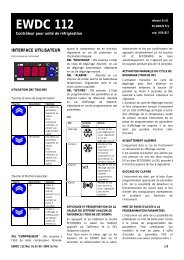K/KU TN 70/72 K/KU TNV 70/140
K/KU TN 70/72 K/KU TNV 70/140
K/KU TN 70/72 K/KU TNV 70/140
Create successful ePaper yourself
Turn your PDF publications into a flip-book with our unique Google optimized e-Paper software.
The following list has been prepared as a guideline to the search<br />
of possible remedies to some anomalies that could be found in<br />
the appliance, it should be understood that this list does not<br />
cover all possible cases. If a safety device trips, this signals an<br />
anomaly in operation; before resetting it, check and eliminate<br />
the cause. The list below gives some of the problems that may<br />
be found with their relevant cause and remedies (in bold print).<br />
WARNING<br />
THE OPERATIONS GIVEN ARE THE SOLE<br />
RESPONSIBILITY OF THE PERSON WHO CARRIES THEM<br />
OUT, AN AUTHORISED SERVICE CENTRE MUST BE<br />
CONTACTED AS THEY HAVE THE NECESSARY<br />
REQUISITES TO CARRY OUT THE OPERATIONS<br />
NECESSARY TO RESTORE NORMAL OPERATION.<br />
IMPORTANT<br />
BEFORE BEGINNING ANY MAINTENANCE WORK ON THE<br />
APPLIANCE DISCONNECT THE ELECTRIC MAINS SUPPLY.<br />
inconvenience<br />
1.0 - ABNORMALLY HIGH PRESSURE.<br />
cause 1.1<br />
DIRTY CONDENSING COIL.<br />
With the compressor operating use a gauge to measure the<br />
condensing pressure. With a condenser inlet air temperature<br />
of +32C the difference between the saturated condensing<br />
pressure and the air temperature must be around 10 °C.<br />
remedy<br />
If the difference is found to be above this value clean<br />
according to the “ CLEANING AND MAINTENANCE “<br />
section at point 2.1.<br />
cause 1.2<br />
THE CONDENSER FAN DOES NOT WORK.<br />
With the compressor operating the fan must operate.<br />
remedy<br />
Before replacing the fan disconnect the supply voltage<br />
and check the electric connections are in good order.<br />
cause 1.3<br />
IMPURITIES PRESENT IN THE CIRCUIT.<br />
If impurities are present the difference between the saturated<br />
condensing pressure and the ambient air temperature will<br />
be over 10 °C.<br />
remedy<br />
Remove all the refrigerant in the circuit, create a vacuum<br />
equal or below 100Pa, charge the circuit with the quantity<br />
of refrigerant given on the serial plate.<br />
cause 1.4<br />
FEEBLE AERATION OF THE ZONE AROUND THE TE-<br />
CHNICAL COMPARTMENT.<br />
remedy<br />
Remove any obstructions to a correct circulation of the<br />
inlet /outlet air to the condenser.<br />
cause 1.5<br />
APPLIANCE HAS JUST BEEN STARTED-UP.<br />
If the appliance has been recently started-up and the fridge<br />
Pag. 22<br />
FAULT FINDING<br />
CONTENTS:<br />
1.0 - ABNORMALLY HIGH PRESSURE<br />
2.0 - ABNORMALLY LOW PRESSURE<br />
3.0 - COMPRESSOR PROTECTIONS<br />
4.0 - SENSOR FAILURE<br />
5.0 - THE COMPRESSOR DOES NOT START<br />
6.0 - EVAPORATOR WITH EXCESSIVE FROST / ICE<br />
7.0 - THE COMPRESSOR RARELY STOPS<br />
8.0 - THE APPLIANCE IS NOISY<br />
9.0 - OVERFLOW OF SELF-EVAPORATING DRAINPAN<br />
compartment has just been filled food stuffs this inconvenience<br />
may be occur.<br />
remedy<br />
It is merely a temporary phase that will disappear the moment<br />
the set point temperature has been reached.<br />
No remedy needed.<br />
2.0 - ABNORMALLY LOW PRESSURE.<br />
cause 2.1<br />
CAPILLARY PARTIALLY BLOCKED.<br />
remedy<br />
Replace the capillary with another of identical dimensional<br />
characteristics.<br />
cause 2.2<br />
DIRTY FILTER DRYER.<br />
With a contact thermometer measure the refrigerant temperature<br />
before and after the filter, a temperature difference of<br />
more than 1 °C is a symptom that the filter has lost efficiency<br />
and should therefore be changed.<br />
remedy<br />
Replace.<br />
cause 2.3<br />
FEEBLE REFRIGERANT CHARGE.<br />
remedy<br />
Eliminate any leaks, if necessary pressurise the circuit<br />
to emphasise them, carry out the vacuum and charging<br />
operations.<br />
3.0 - TRIPPED COMPRESSOR PROTECTION.<br />
cause 3.1<br />
THE THERMOSTAT DOES NOT COUNT THE DELAY<br />
TIME.<br />
Adjacent start-ups don’t allow the pressures the equalise.<br />
remedy<br />
Check relevant parameter and restore to factory setting<br />
if necessary.<br />
cause 3.2<br />
SUCTION GAS TEMPERATURE ABOVE THE OPTIMUM<br />
VALUES.<br />
remedy<br />
- Check that the expansion device is working correctly.<br />
- Check the refrigerant charge and eventually for any<br />
leaks, if necessary pressurise the circuit to emphasise<br />
them, carry out the vacuum and charging operations.<br />
4.0 - SENSOR FAILURE.<br />
cause 4.1<br />
FAULTY ELECTRIC CONTACT.<br />
remedy<br />
Check the connections are in good order and eventually<br />
replace the sensor.<br />
cause 4.2<br />
SENSOR NOT WORKING.<br />
remedy<br />
Use a tester to check the sensor is working and replace<br />
if necessary.<br />
5.0 - THE COMPRESSOR DOES NOT START.<br />
cause 5.1<br />
NO POWER IS REACHING THE TERMINALS OF THE<br />
ELECTRIC MOTOR.



